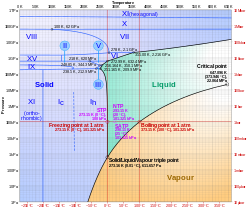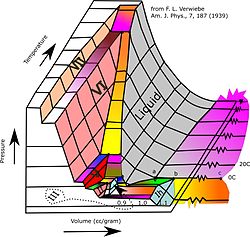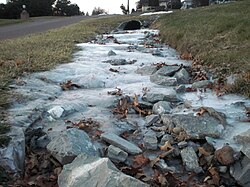Ice

Ice is the common name for frozen water. Other liquids, such as ammonia or methane or milk, are called 'milk ice', for instance, instead of just 'ice'. Liquid water becomes solid ice when it is very cold. The freezing point is 0° Celsius (32° Fahrenheit or 273 kelvin).
Ice can be made in a home refrigerator or freezer. If water is put in a freezer and left for a while, the water gets very cold and will freeze solid, creating ice. Water can be placed into a copper (or other metal) container to cause it freeze into ice faster. Water can freeze faster than in a plastic ice tray.
How ice is formed
Unlike other liquids, water expands as it freezes to become ice. It floats on water because ice has less density than water. This is very unusual – most liquids gets more dense as they cool: water ice is an exception. Liquid water expands by about 9% as it becomes ice – it takes up more space. This is because the water molecules are actually farther apart instead of being closer together. The molecules in an ice crystal are arranged in a way that makes it less dense than liquid water.
If water in plumbing freezes, it can burst the water pipe. Water in glass bottles can make them explode when it freezes. Water freezing in rock cracks can expand enough to split hard rocks apart; this is an important geological weathering process that can wear down mountains and make rock into soil.
Salt water
Salt water needs a lower temperature to freeze than pure water. Most of the salt does not enter the ice, so the resulting ice is less salty than the water. This fact has sometimes been used for desalination. Salty ice is not as strong as frozen pure water. Salt that is added to ice melts it, if it's not too cold: the salt progressively eats into the ice, forming brine which does not freeze at that temperature.
Geography of ice
Because ice floats, even large bodies of water which freeze, like some oceans, only form ice on the surface. Most lakes never freeze to the bottom. Even the coldest oceans, like the Arctic Ocean, only freeze on the top, leaving liquid ocean circulating below. Because of this the Earth's oceans are able to redistribute heat. The climate of the Earth has less extremes of heat and cold than it would otherwise. A solid ocean would not circulate heat. But because ice floats on the surface the water beneath can continue to circulate. Ice on the surface stays exposed and readily melts when the temperature rises.
Big bodies of ice on land are called glaciers. Antarctica has most of the world's ice.
Ice ages
Climate change happens all the time. When it is cold it is called an ice age. During ice ages large areas of the Earth are covered in ice, snow and glaciers. The causes of ice ages are complex, and not entirely known, but see Milankovic cycle. Global warming is currently affecting the Earth's ice resources and its causes are also very complex.
Dry ice
There is also 'dry ice'; it is frozen carbon dioxide. Dry ice exposed to normal air gives off carbon dioxide gas that is odorless and colorless. The gas is so cold that when it mixes with air it cools the water vapour in the air to fog, which looks like a thick white smoke. It is often used in the theatre to make fake fog or smoke.
+{{{1}}}−{{{2}}}
| Wikimedia Commons has media related to Lua error in Module:Commons_link at line 62: attempt to index field 'wikibase' (a nil value).. |
Ice Media
Log-lin pressure-temperature phase diagram of water. The Roman numerals correspond to some ice phases listed below.
Frozen waterfall in southeast New York
Feather ice on the plateau near Alta, Norway. The crystals form at temperatures below −30 °C (−22 °F).
Ice on deciduous tree after freezing rain
A small frozen rivulet












